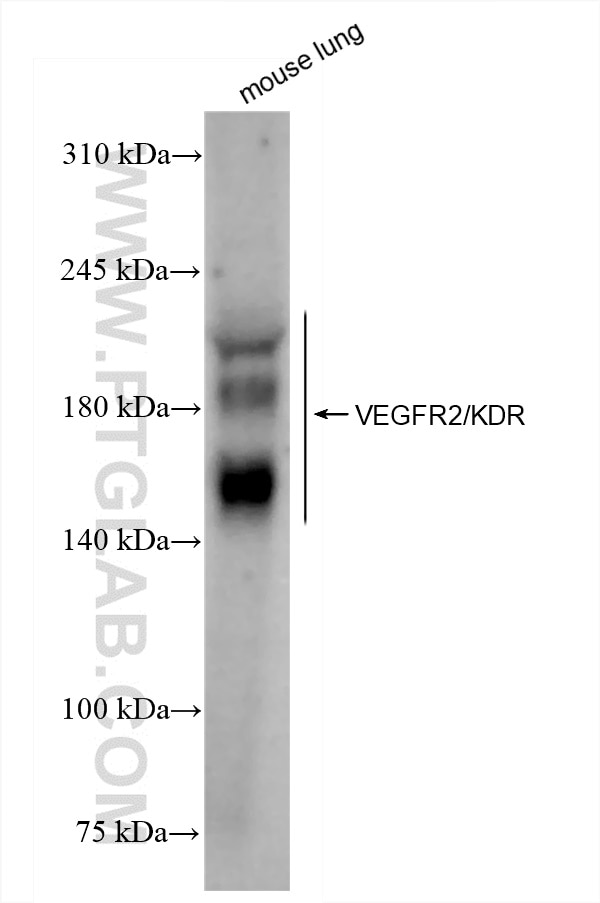VEGFR2/KDR Recombinant antibody
VEGFR2/KDR Recombinant Antibody for WB, ELISA
Host / Isotype
Rabbit / IgG
Reactivity
mouse
Applications
WB, ELISA
Conjugate
Unconjugated
CloneNo.
240214D7
Cat no : 83366-1-RR
Synonyms
Validation Data Gallery
Tested Applications
| Positive WB detected in | mouse lung tissue |
Recommended dilution
| Application | Dilution |
|---|---|
| Western Blot (WB) | WB : 1:5000-1:50000 |
| It is recommended that this reagent should be titrated in each testing system to obtain optimal results. | |
| Sample-dependent, Check data in validation data gallery. | |
Product Information
The immunogen of 83366-1-RR is VEGFR2/KDR Fusion Protein expressed in E. coli.
| Tested Reactivity | mouse |
| Host / Isotype | Rabbit / IgG |
| Class | Recombinant |
| Type | Antibody |
| Immunogen | Fusion Protein 相同性解析による交差性が予測される生物種 |
| Full Name | kinase insert domain protein receptor |
| Calculated molecular weight | 150KD |
| Observed molecular weight | 150-190 kDa |
| GenBank accession number | NM_010612.2 |
| Gene symbol | VEGFR-2 |
| Gene ID (NCBI) | 16542 |
| Conjugate | Unconjugated |
| Form | Liquid |
| Purification Method | Protein A purification |
| Storage Buffer | PBS with 0.02% sodium azide and 50% glycerol pH 7.3. |
| Storage Conditions | Store at -20°C. Stable for one year after shipment. Aliquoting is unnecessary for -20oC storage. |
Background Information
VEGFR2, also named CD309, KDR, and FLK1, is a receptor for VEGF or VEGFC. VEGFR2 which belongs to the protein kinase superfamily, has a tyrosine-protein kinase activity. The VEGF-kinase ligand/receptor signaling system plays a key role in vascular development and regulation of vascular permeability. In the case of HIV-1 infection, the interaction with extracellular viral Tat protein seems to enhance angiogenesis in Kaposi's sarcoma lesions. VEGFR2 functions as the main mediator of VEGF-induced endothelial proliferation, survival, migration, tubular morphogenesis, and sprouting.
Protocols
| Product Specific Protocols | |
|---|---|
| WB protocol for VEGFR2/KDR antibody 83366-1-RR | Download protocol |
| Standard Protocols | |
|---|---|
| Click here to view our Standard Protocols |



